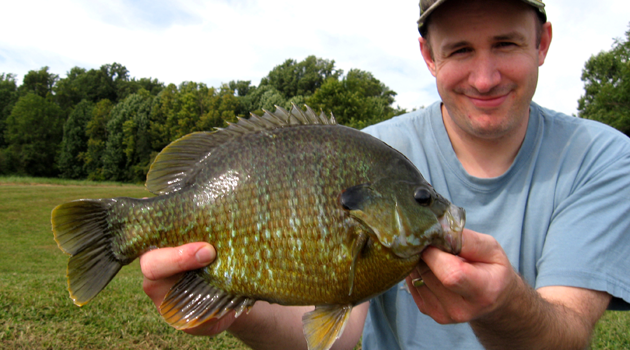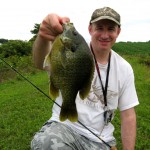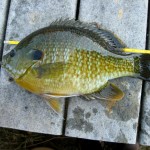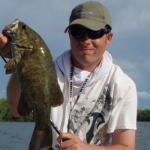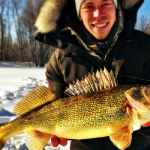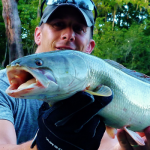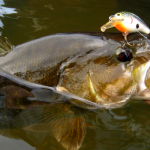By Jim Gronaw
We weren’t on the bank long before I heard my son, Matt yell ‘got em’ and I looked over to see his long, 11 foot spinning rod arched heavily under the weight of a good fish. We were ‘drop-shot’ fishing…a way to present a bait or lure to deeper, weed-hugging panfish and bass. As he played the fish in, we could see that this was no ordinary sunfish. As we had often done when in quest of trophy bluegills or hybrid sunfish, we had a long-handled net ready and scooped the fish up when it had tapped-out. The fish was over 11 inches and pushed 1 ½ pounds…the first of several trophy hybrid sunfish we would catch and release that day.
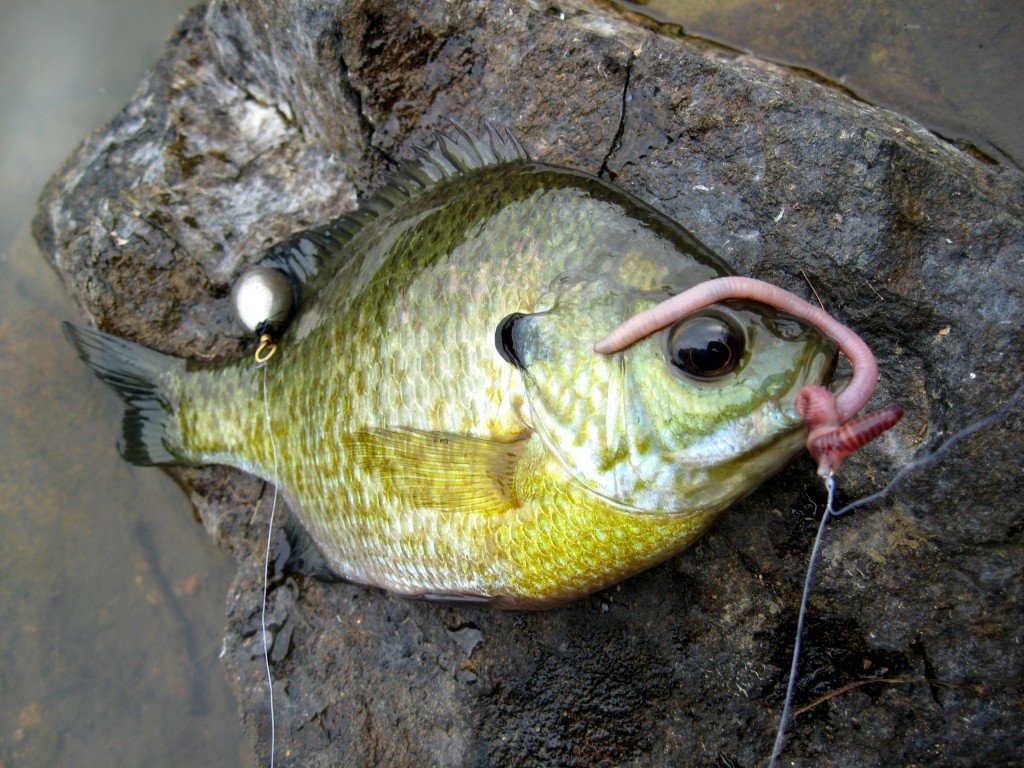
The premise for drop-shot angling is nothing new. Bass anglers nationwide have been using this rig for more than a decade to catch deep-water largemouths and smallmouths with a variety of plastic options. The basics are simple…at the end of your line you have a weight that bounces, drags or rests on the bottom. At 10 to 30 inches above the weight, you have a baited hook that maintains the location above the lake floor and coaxes a variety of gamefish. You can slow-hop, lift and drop or drag the offering along the lake bottom. You can fish it from a boat or shore.
I started drop-shotting for big fall bluegills in October of 2012 in a small public lake in southern Pennsylvania. By chance, I ran into an angler who was catching three to my one and I just had to ask a few questions. He was gracious and kind, showing me everything he was doing to include lending me some weights and offering his prefered mealworms for bait. It looked easy, but there was more to it. He would make a long cast, let his baits touch the bottom, then hold a tight line with his lightweight Ugly Stik. Using 6-pound test mono, he would feel the tap-tap of a biting bluegill, then set the hook as it got a little more forceful.
His tactic was deadly, and he was using a pair of leadered # 6 baitholder hooks, often catching two half-pound or better bluegills at one time. In the mix were some giant pumpkinseed sunfish and some boss yellow perch. He pointed out that when slack was imparted to a ‘tight’ line, that was the strike of a fish that had picked up the bait and was heading toward the angler…time to set the hook!
I was a little under-gunned with 2 and 4-pound line, but was still able to make lengthy casts and got two dozen big gills for the pan that day. Hey…a new tactic and some fresh fillets, and I had made a new fried as well! This year, I have toyed with it some more and am amazed at how effective it can be when the standard bobber/jig/bait options don’t pan out.
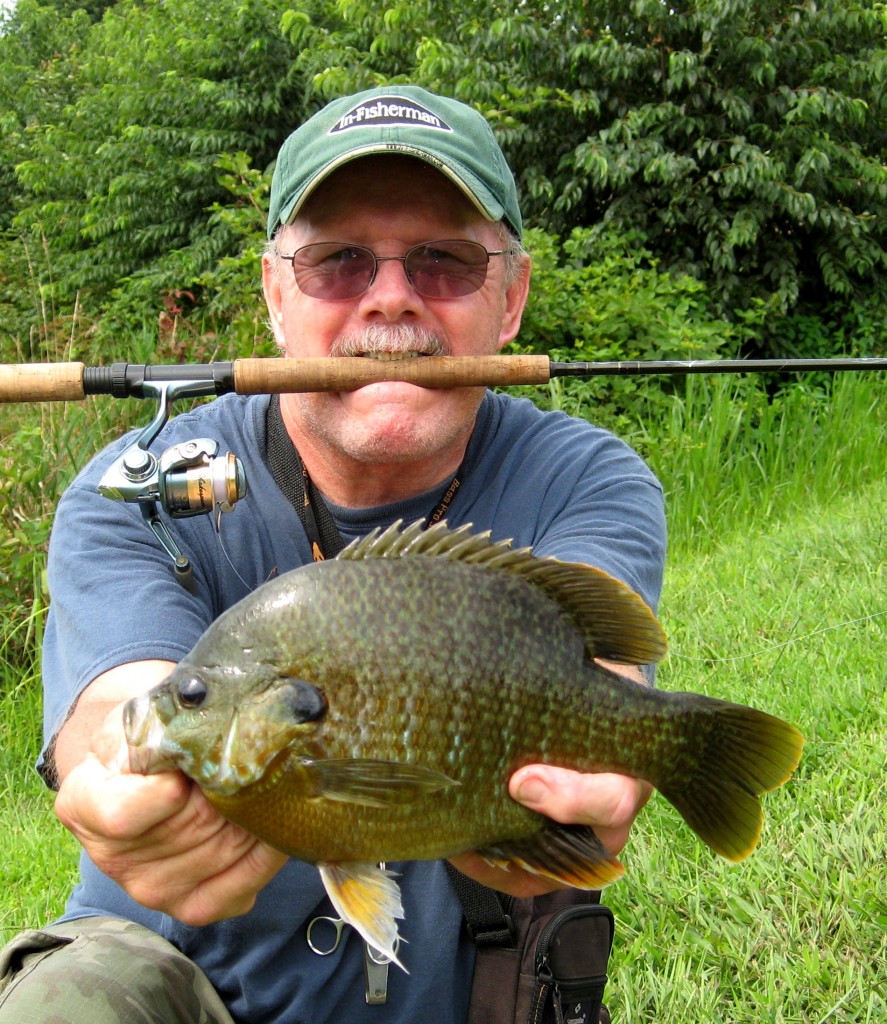
Our basic rig looks like this: on 8 pound line, tie a # 6 or # 8 long-shanked Aberdeen hook about 30 inches up from the end of your line with either a Palomar or improved clinch knot. Below the hook, at the very end, tie on a small snap swivel. To the swivel attach a bell sinker. The swivel enables you to switch various size sinkers, as conditions dictate. We have been using 1/4th and 3/16th ounce weights for our work lately, sometimes heavier. Bait your small minnow, mealworm or garden worm on the hook and you’re ready. The long-shanked hook allows for easier unhooking chores and seldom do panfish swallow the hook so deep that you can’t release your fish if you want. The reason we up to line as high as 8, even 10, pound test is that weedgrowth may be at it’s thickest and toughest during mid-summer, and you’ll need some strength to get fish, and rigs, out of the salad. Strike detection has not been an issue until the water temperatures get into the upper forties, much later into the fall.
For retrieves, much of that depends on bottom conditions. Drop-shotting does not work well over cragy or rocky substrate where frequent hangups and loss of tackle will occur. It does work well amongst scattered too medium weedy bottoms when you can suspend a bait in open pockets in the weeds or move the bait just with the occasional twitch of the rod tip as the bottom weight remains stationary. If you feel weed growth holding up your rig, you can ‘pop’ it loose with a quick snap of the rod tip. We prefer to use longer rods when drop shotting from shore as they help greatly in hook setting efforts with longer cast. Plus, you can leverage a tanker perch, crappie or bull bluegill better with a 10 or 11 foot rod than with traditional ultra light sticks.
During our recent outing in quest of the monster hybrid sunfish we hooked some and missed some, totaling eight of the super panfish. These were bluegill X green sunfish crosses…a popular pond addition for pond owners who want fast-growing, aggressive fish for family outings and kids enjoyment. Since they had moved deep, away from the shoreline and into heavy weed cover, drop-shotting was our best option to put some trophies in the net. Small pieces of night crawlers and large mealworms were the prefered baits. Still, it required patience and attention to the rod tip for indications of the soft strikes from even these Sumo-sized sunfish. Our three largest of the day all exceeded 12 inches, and the top hyb of the day went 12 ½ inches, weighing 1 pound, 14 ounces. Wow!
Drop-shotting is best executed from a boat or kayak, but you can pull off big-time catches from shoreline venues as well. In the fall months, bluegills, yellow perch and boss pumpkinseeds will continue to relate to deep weed edges of most natural and man-made lakes. Although slip-bobber tactics can do very well, I like the tap-tap of a pound-sized panfish telegraphed at my rod tip followed by a solid hookset. If you are shorebound the longer rods enable better casting distance and greater line pickup on the hookset. Whether bottom or weed-hugging panfish, the drop-shot tactic in it’s basic form can put the hurt on autumn slabs. Put it in your arsenal, along with the favored regional live baits, and see if your score on bull ‘gills and porker perch doesn’t increase this fall.
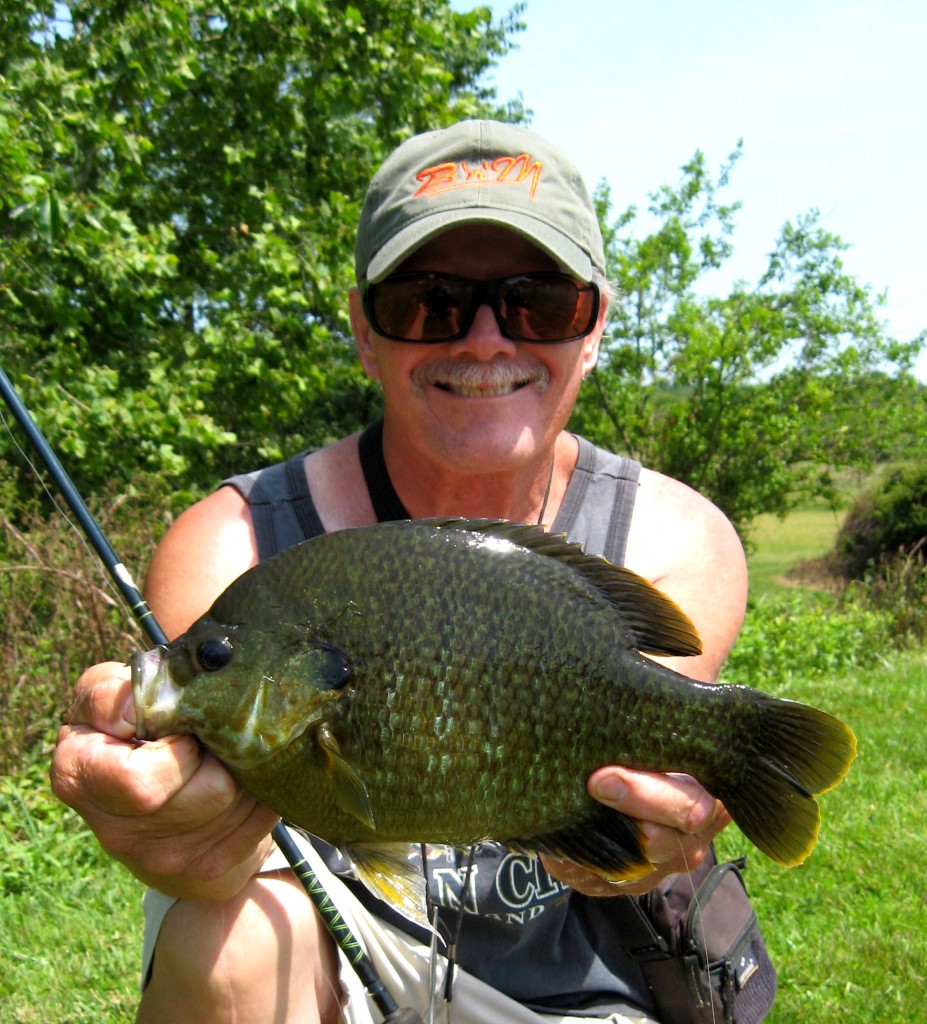
Article by Jim Gronaw, published in Fishing-Headquarters Online Magazine, issue 20, September, October & November, 2014.



